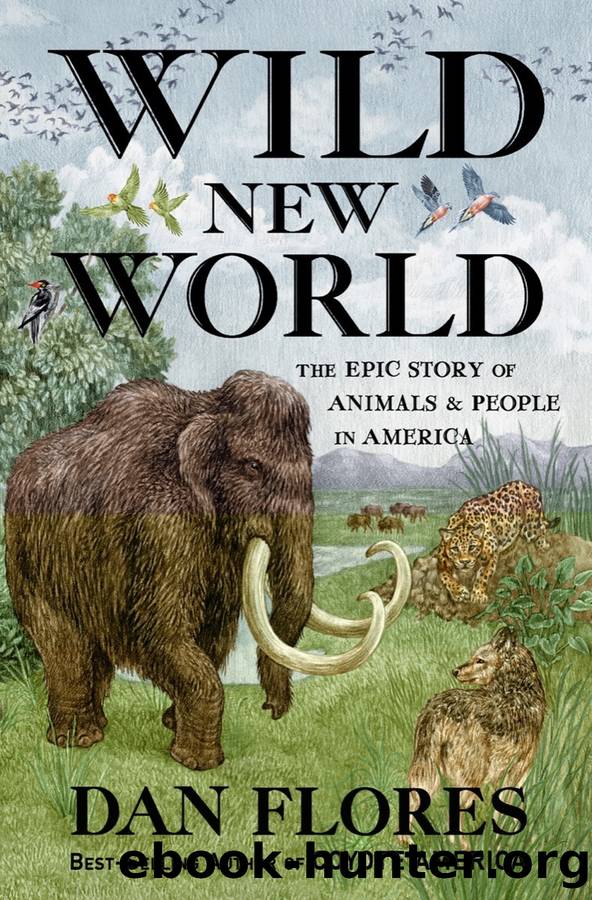Wild New World: the Epic Story of Animals and People in America by Dan Flores

Author:Dan Flores
Language: eng
Format: epub
Publisher: W. W. Norton & Company
Published: 2022-09-10T00:00:00+00:00
INTELLECTUALS, MINISTERS, and journalists spilled vast amounts of ink and heated words on Darwinian evolution, some of it even witty. One critic demanded to be shown a bed of oysters morphing into the British parliament. A reviewer wrote that âif we are so little above the dog, we may as well make out the dog to be as fine a fellow as possible.â But in the American West there was still money to be made from wild animals and that trumped any philosophical debate elites might be having about humanityâs animal origins. Working-class westerners saw things in more practical terms. Even if we were more like animals than weâd thought, animals hadnât invented guns. We had.
For wildlife in western America, guns and traps meant every decade in the nineteenth century was worse than the last. The 1820s had seen the near wipeout of sea otters. Beaver colonies were so devastated and beavers so scarce by the end of the 1830s that silk headgear replaced beaver hats in the market. The 1840s saw former New Englanders who were now Mormons arrive at the western foot of the Rocky Mountains and resume the old Puritan war against âwasters and destroyersâ (wolves and cougars). Mining strikes from the late 1840s through the 1870s dropped tens of thousands of hungry miners into the outback mountains of California, Nevada, Colorado, Idaho, and Montana. And the newest transportation technologyâthe railroadsâpushing across the West brought in huge crews of workers from the 1860s to the 1880s. Market hunters, some of them Natives, who supplied all these mining and track-laying camps unleashed episode after episode of regional wildlife destruction. Californiaâs experiences were typical. When miners first arrived they were gobsmacked by the wildlife they saw: forty grizzlies in sight at once from a hilltop in what would be Humboldt County, thousands of elk scattered over the grassy sweeps of future Sonoma and Napa Counties. There were four million acres of wetlands in the Central Valley, habitat for an estimated half million Tule elk and in excess of a million and a half tricolored blackbirds, whose flocks set up a din audible for miles. Then came the strikes and the miners. By 1895 a single Tule elk herd of twenty-eight animals remained alive.
Some of the new territories and states in the West grew alarmed enough that they tried to legislate a modicum of animal protection. California attempted a closed season on both pronghorns and elk in 1852, four years into the Gold Rush. Nevada banned the killing of mountain sheep and goats, and the territory of Idaho tried to stop the destruction of all major speciesâbuffalo, elk, bighorns, goats, pronghorns, and deerâduring their spring birthing seasons. Their intentions were good but the West was an awfully big place for any enforcement. As a correspondent to the magazine American Farmer put it, âThe right to hunt wild animals, is held by the great body of the people . . . as one of their franchises.â Whenever governments tried to limit
Download
This site does not store any files on its server. We only index and link to content provided by other sites. Please contact the content providers to delete copyright contents if any and email us, we'll remove relevant links or contents immediately.
How to Do Nothing by Jenny Odell(3232)
A Forest Journey by John Perlin(3027)
The Plant Messiah by Carlos Magdalena(2883)
Babylon's Ark by Lawrence Anthony(2620)
The ESV Study Bible by Crossway Bibles(2502)
Energy Myths and Realities by Vaclav Smil(2438)
Fatal Storm by Rob Mundle(2171)
Abbey in America by Murray John A(2049)
Witness Tree by Lynda V. Mapes(1887)
Brokeback Mountain by Annie Proulx(1782)
Client Earth by James Thornton(1733)
Shadows on the Gulf by Rowan Jacobsen(1717)
Coming Back to Life by Joanna Macy(1685)
Cosmos by Carl Sagan(1680)
Water Rights and the Environment in the United States by John Burch(1643)
Mycelium Running: How Mushrooms Can Help Save the World by Paul Stamets(1640)
Ten Billion by Stephen Emmott(1609)
The overachievers by Robbins Alexandra(1528)
Ecological Intelligence by Daniel Goleman(1507)
